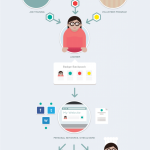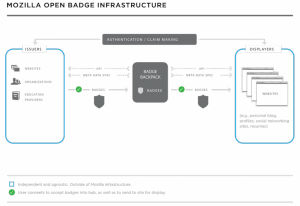With a growth of over 1400% in 2013, the concept of “badging” looks set to gain further popularity within the next few years, particularly with education providers.
The whole concept of Open Badges can be likened to Scouting badges, whereby a Scout demonstrates some skill or competency to the satisfaction of the Scout leader who then awards the badge which is proudly displayed on the Scout’s uniform.
The Open Badges Infrastructure (OBI), which has been developed by the Mozilla Foundation, allows people to earn “digital badges” as recognition for achieving skills and knowledge, both online and offline. Consequently, “badges” offer an informal method of accrediting learning and are ideal for recognising extra-curricular activities or to reflect educational experiences beyond the classroom, such as studying abroad or student ambassador schemes.
They can also be used to ensure that activities which contribute towards learning don’t go unrecognised, or to reward students for completing small tasks as steps towards a more substantial goal.
Being able to earn a badge for something could increase student motivation and result in better engagement with the course.
Benefits for Students
Increased motivation, as previously mentioned, isn’t the only potential benefit that this concept could bring. Badges provide students with the opportunity to reflect on what they’ve achieved throughout their education or time at university. They support lifelong learning and the kind of knowledge which comes from personal initiative and investigation. In time, badges could serve as part of a CV or portfolio which can be shown to prospective employers to provide a more detailed insight into the student’s learning, including both the hard and soft skills that were acquired.

The Technology
Mozilla’s Open Badges Infrastructure (OBI) is the only open and shared technical standard for badging and credentialing. The Open Badges Infrastructure (OBI) uses graphical badges which have associated meta-data to define information such as the award criteria, the person who earned the badge, the issuer (e.g. an institution), a URL (Uniform Resource Locator) to verifying evidence and an expiry date (if applicable). Badges are digitally signed and verified; the description and criteria for earning the badge are digitally encoded for others to see.
Badges can then be placed in an individual user’s “digital backpack” which can then be displayed on social networking profiles, job search sites or personal Web pages.
Individuals can control their badges and change privacy settings within their digital backpack to determine which badges are displayed.

Creating & Issuing Badges
At the moment, the number of badge systems is still quite limited, but as the OBI is more broadly adopted, a host of issuers and endorsers are likely to emerge. OpenBadges.me provides the facility to create badges, whilst Badg.us can be used to issue badges. With most systems, users are required to sign-in with a Mozilla Persona (Yahoo! and Gmail email addresses can be used without having to create a new password). There’s also integration with other platforms, including VLEs (Virtual Learning Environments) such as Blackboard.
Blackboard Integration
The “Achievements” tool in Blackboard enables module leaders to create badges which can be earned by students for completion of a module or for meeting key milestones within a module. As an example, you may decide to offer a badge for completing a short series of informal tests at the end of each topic. Since the tool is integrated with Mozilla’s Open Badges, students can export badges earned in Blackboard to their “digital backpack”.
Who’s Using Them?

At the moment, the use of badges in Higher Education is still in its infancy. There are, however, numerous groups, organisations, community projects and Web entities who are currently issuing badges for all sorts of things, particularly to certify learning or the mastery of skills. Mozilla themselves, for instance, have a series of “Webmaker” badges which people can earn for demonstrating various HTML skills. The Khan Academy offers numerous badges including an “Atomic Clockwork” badge which requires students to watch videos or hone a skill for 30 consecutive days.
Meanwhile, the Dallas Museum of Art are currently using badges to allow visitors to keep track of engagement with special exhibitions, demonstrating that the technology can also be used to reward offline activities.
Any downsides?
As with any new technology, there are always going to be some disadvantages. Acceptance is probably one of the major issues and until badges are broadly accepted as legitimate indicators of education, skills or experience, people may be hesitant to start issuing them. For awarding bodies, a key concern could be how to control the issuing of badges and ensure consistency. In other words, if an educational institution is going to adopt the concept, there needs to be a standard for badge design, awarding criteria and so on. There needs to be some form of control over what is actually worthy of a badge in order to avoid abundance, otherwise it will be difficult to establish their value. There’s also the possibility that some will see the whole concept as “childish” and will retain the notion that skill and knowledge should only be rewarded formally.
Want to find out more?
If you’re interested in finding out more information about Open Badges, take a look at the following resources:
- Description of the Mozilla Open Badges Infrastructure: http://openbadges.org
- Information on the goals, missions and vision around Open Badges: http://wiki.mozilla.org/Badges
- Mozilla Open Badges Blog: http://openbadges.tumblr.com/
- Educause – 7 Things You Should Know About Badges: http://net.educause.edu/ir/library/pdf/ELI7085.pdf
